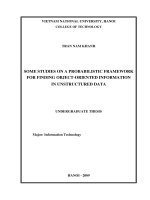Circumcision studies
Bạn đang xem bản rút gọn của tài liệu. Xem và tải ngay bản đầy đủ của tài liệu tại đây (1.07 MB, 28 trang )
CIRCUMCISION IN
NEWBORN MALE
Dr.Trần Quốc Việt
Department of General Surgery
Pediatric Hospital 2
History of Circumcision
•
Ancient Egypt - performed to improve
male hygiene and for purification
•
Judaism, Islam – Religious reasons and
cleanliness
•
Africa and Australia - Rite of passage
into manhood
•
The United States is the only country in
the developed world : majority of male
infants are circumcised for nonreligious
reasons (Up-to-date 2013)
in newborn male
Male Circumcision
TASK FORCE ON CIRCUMCISION
Pediatrics 2012;130;e756; originally published online August 27,
2012;
STATEMENT OF THE ISSUE
AAP 1999: Despite of health benefits of
circumcision, but did not deem the
procedure to be a medical necessity for
the well-being of the child.
2007, AAP formed a Task Force
charged with reviewing current evidence
on male circumcision and updating the
policy
AAP 2012
DATABASES
EPIDEMIOLOGY IN U.S.
80%
INCIDENCE
INCIDENCE
Male Circumcision and Diseases,
Morbidities,
and Sexual Function/ Satisfaction
STIs, Including HIV
•Preputial space : “trap” pathogens, secretions and
survival and replication.
•Uncircumcised penis become keratinized
more susceptible to irritation/infection
Reduction in STDs.
•
40% to 60% for male circumcision in reducing the risk of HIV
acquisition among heterosexual males in areas with high HIV
(Africa)
•
CDC : newborn circumcision performed to prevent HIV
infection is cost-effective. All parents of newborn males should
be given the choice of circumcision.
•
Male circumcision is associated with a lower prevalence of
HPV infection, and HSV-2 transmission (good evidence, RCT)
•
Others STDs : less strong, non significant (Siphyllis,
gonorrhea, or chlamydia
Decrease in UTI’s
• Circumcised <2 age less UTI than Uncircumsied (good
evidence,2 well-conducted meta-analyses and a cohort
study)
• The risk of UTI is 3 to 10 fold lower in circumcised infants
• The absolute risk of UTI is small (1%) in male infants; the
number needed to circumcise approximately 100, to
prevent 1 UTI.
• A decreased prevalence uropathogens in the periurethral
area 3 weeks after circumcision (fair)
Decreased cancer of the penis
• Squamous cell cancer of the penis is very rare, less than 1
per 100,000 males
• Phimosis significantly elevated risk of incasive cancer (OR
11.4). Intact prepuce and no phimosis (OR: 0.5).
• Having to do 909 circumcisions to prevent 1 penile cancer
event (good evidence)
• circumcised men have a lower prevalence of oncogenic
(high-risk) and nononcogenic (low-risk) HPV when
compared with uncircumcised men
• Must perform circumcision in infancy or the protective cancer
benefit is lost.
Reduction in penile inflammation
and retractile disorders
– Meatitis and balanitis are less
common in circumcised men
– Decrease in phimosis and
paraphimosis & in surgical
procedures needed to correct
these
Cervical cancer in female
partners
•
Leading cause of death for women in
developing countries; more than 80%
deaths
• Uncircumcised men may be more
likely to acquire and transmit HPV to
their partners
• The overall rate of cervical cancer for
women who currently had
circumcised male partners was not
significantly decreased
Sexual sensation and satisfaction
• No statistically significant
differences
• Circumcised men reported
significantly less pain on
intercourse than uncircumcised
men (Ugandan 5000).
Complications
• Bleeding : the most common (0.08% - 0.18%), Infection
(0.06%), Penile injury (0.04%).
• Late complications :
– Excessive residual skin (incomplete circumcision),
– Excessive skin removal,
– Adhesions (natural and vascularized skin bridges),
– Meatal stenosis,
– Burried penis.
–…
Major Complications
• Glans or penile amputation
• Transmission of HSV after mouth-to-penis
contact by a mohel (jewish ritual circumcisers
• MRS infection,
• Urethral cutaneous fistula,
• Glans ischemia,
• Death.
Parental decision-making
• Correct, nonbiased information about circumcision
before conception and early in pregnancy
• The potential benefits and risks, and by ensuring
that they understand the elective nature of the
procedure.
• Weigh the health benefits and risks in light of their
own religious, cultural, and personal preferences
Parental Decision-Making
Circumcision
RATE
health/ medical benefits
36,9% - 67%
Social concerns
22,8% - 37%
Religious requirements
11% - 19%
In 4 cross-sectional studies (fair evidence)
•The decision of circumcision is frequently made early in the
pregnancy and even before conception.
•Financial barriers to the circumcision decision (fair)
The Procedure
• 3 Major Methods :
• GOMCO clamp,
• Plastibell device,
• Mogen clamp
Diagram of dorsal nerve block
The Gomco clamp
24
Mogen Clamp
25









